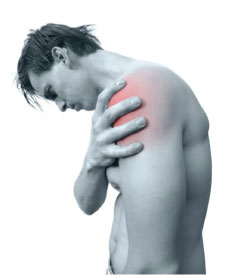One of the most common questions we face as Osteopaths is “What do you mean my hip pain isn’t coming from my hip?”
 Referred pain as the name suggests, is a seemingly strange (but very common) problem, where the pain one feels doesn’t actually originate from the specific area that it’s felt in. The origin of the pain is actually elsewhere in the body. Though this might sound a little strange, the reality is we’re probably all pretty familiar with the idea already.
Referred pain as the name suggests, is a seemingly strange (but very common) problem, where the pain one feels doesn’t actually originate from the specific area that it’s felt in. The origin of the pain is actually elsewhere in the body. Though this might sound a little strange, the reality is we’re probably all pretty familiar with the idea already.
An example or two here might help… So when you see someone have a heart attack in the movies they’ll usually have pain in the left shoulder or down the left arm rather than in the heart itself. That’s referred pain! Or when you bite into an ice-cream and give yourself a classic ice-cream headache or ‘brain freeze’. That’s referred pain too!
Referred pain is the result of having a global network of interconnecting nerves that create overlap or communication between pain signalling pathways from different areas of the body.
There are several proposed mechanisms for pain referral but if truth be told, we haven’t really nailed down the hows and whys of referred pain. Much of it may actually relate to how we develop as embryos.
The pain felt with referred pain is usually deep and difficult to pinpoint. At times however, referred pain can result in more specific patterns of numbness, pins and needles or tingling sensations in the skin.
There are many conditions that involve referred pain. Many of them relate to the internal organs such as the back pain can often results from kidney stones or appendicitis. But it is also possible though that we get referral from one joint to another like knee pain associated with hip pathology or shoulder pain associated with neck injuries.
One of the most common examples of referred pain we see at Melbourne Osteohealth is headaches. Pain can be referred to the base of the skull, the top of the head, the forehead or the temples from a number of structures inside the skull, in the neck or face (including the jaw or TMJ).
The source of the problem with headaches is most commonly a musculoskeletal structure such joints or muscles of the neck or jaw. Pain signals travel through the nerves between the neck and the head or face, and crossover in the nerve pathways results in pain being felt in the forehead, or temples.
Osteopaths are specially trained to locate the underlying source of pain and to determine if pain or headaches are coming from a local structure or being referred from a distant joint or organ.
We can then use hands on treatments to help restore proper function to the area.
Treatment
The aims of the treatment are:
- Reduce inflammation and tissue congestion
- Improve movement of joints and associated tissues
- Relax painful muscle spasms
- Strengthen weakened muscles
Osteopathic treatment may involve stretching and massage techniques to tight and tender muscles, gentle mobilisation techniques and manipulation of the effected joints.
You may also be given exercises based on your personal need and fitness level.
